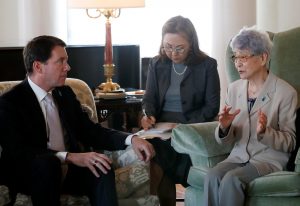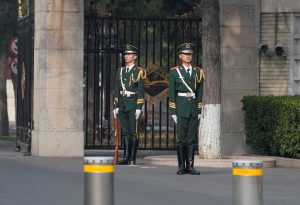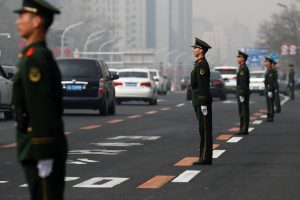
By Sue-Lin Wong
YANBIAN, China (Reuters) – I sat on a metal bench, the chill seeping through my down jacket, as a Chinese government official towered above me, shouting.
It was a Saturday morning in March, just after daybreak. I was on China’s border with North Korea, trying to follow up on reports that the country was making preparations for a large-scale influx of North Korean refugees. As usually happens when I report from this part of the world, the Chinese authorities were telling me to go away.
Cui Changwan, the local government official who had been called in when border guards stopped me, shoved a document into my hands and jabbed his finger on the page which stated that “without approval, foreigners are not permitted to enter areas out of bounds to foreigners.”
I asked him to show me the rule that said I was in such a place.
“It’s an internal document which you’re not allowed to see,” he replied, spittle flying at me. In the office behind us, a colleague of his played video games.
China has long posted military and police along its border with North Korea. The border is marked by two rivers which often freeze over in the winter, making it easier for North Koreans to cross – a particular concern for China’s state security.
Despite a recent thaw in relations between North Korea and both China and the United States, locals say that over the past six months, China has stepped up military patrols here. Media reports in South Korea and elsewhere say China has been bolstering its defences along the border – some have said as many as 300,000 troops have been added.
Two sources with knowledge of the matter told Reuters the number of Chinese military on the border could be up to 200,000 or possibly 300,000. This would be an increase from just 100,000 in August last year. China’s foreign ministry declined to respond to a question on the numbers or the intensified activity.
Many of the military bases are in Yanbian, an area which includes Sanhe village, where the authorities had detained me.
On assignment in November with photographer Damir Sagolj, we documented the ways some people who live on the frontier say they interact across it. Spots like this village underline how Beijing also maintains a wary eye on its neighbor.
Chinese border control staff called in at our hotel. We were prevented from continuing our trip along the border at three separate roadblocks around Tumen. At one point, plain clothes police hovered as Damir took photos of tourists. They followed us in two cars.
“We have secret military installations here,” one soldier told me in November. A declassified CIA document from May 1970 says China had begun constructing personnel trenches – with possible forward firing positions facing the border – in 1969.
Tens of thousands of North Koreans have already traveled through China as they left one of the world’s poorest countries. Around 31,000 of them eventually sought refuge in South Korea. Others have stayed in China.
Both China and North Korea have bolstered efforts to prevent North Koreans from making the journey to South Korea through countries including Laos and Thailand, according to Human Rights Watch. Last year, it said, Chinese authorities intensified their crackdown on arriving North Koreans and the networks which help them. China says it handles North Korean arrivals in accordance with humanitarian principles; North Korea’s mission to the United Nations didn’t respond to a request for comment.
If war were to break out in North Korea, the Chinese have made extensive plans to respond and are likely to intervene in some way, two diplomatic sources said. China’s foreign ministry told us it consistently supports denuclearisation and peace on the Korean peninsula and believes in the need for dialogue.
Late last year, a document that appeared to be from a Chinese state-owned company was leaked online, outlining plans for China to build refugee camps along its border with North Korea. At the time, neither the company or the government made any comment on the plans.
Around 20 people I spoke to who live along or near the border said they had seen no sign of camps being built. But none doubted plans were being made.
Many locals said the government’s focus was fortifying its military presence. If North Korea were to collapse and millions were to rush into China, the Chinese government could easily convert abandoned homes in villages all along the border into temporary accommodation, they told me.
“Border regions anywhere in the world are sensitive, but it’s particularly sensitive up here because the river is narrower and historically there has been a lot of interaction between the two sides,” said Li Zhonglin, a China-North Korea specialist at Yanbian University.
In recent years, Chinese media have reported that villagers have been killed by North Koreans sneaking across the border, often in search of food.
China is more likely to look at the issue of North Koreans rushing across its border as a military threat rather than a humanitarian disaster, some Chinese academics say.
Yang Guosheng tends to 100 cows near China’s border with Russia and North Korea. He said Chinese border control personnel come by at least 10 times every day, night and day. There are cameras at the edge of his property, which hugs the bank of the Tumen river.
All along the border, signs remind people to be on the lookout for spies and other suspicious activities.
(Additional reporting by Hyonhee Shin in Seoul; Edited by Sara Ledwith)












